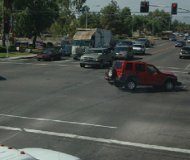9/25/2012
Oakland, California Accidents Decreased with Longer Yellow TimesLonger yellow times had more of a safety effect than the use of red light cameras in Oakland, California.

An analysis of accidents in Oakland, California suggests lengthening yellow times at red light camera intersections produced more of a safety benefit than the introduction of photo enforcement. As TheNewspaper reported last week, the city's transportation department experimented for about four months with increased yellow warning times at camera intersections until the police lieutenant who worked with the camera vendor Redflex Traffic Systems complained about what he saw as an alarming reduction in the number of citations being issued. The timing was then shortened back to its original value.
Safer Streets LA Executive Director Jay Beeber used the California Highway Patrol's Statewide Integrated Traffic Records System to examine the impact of the timing change on red light running-related intersection accidents between December 27, 2009 and April 27, 2010, when the signal timing was one-second longer. He concluded in the year following the installation of red light cameras, only one of the 22 accidents happened when the yellow signals were longer. Beeber concluded the overall "after" period figures were otherwise unimpressive.
"Although there was an overall reduction in the number of collisions, the majority of the intersections had either an increase or no change in the number of collisions," Beeber wrote. "At the five intersections with reductions, four had only one or two fewer collisions. These small changes in the number of collisions cannot be considered to be statistically significant."
Local activist Roger Jones, organizer of the Red Light Camera Protest Group of Alameda County, asked Beeber to conduct an independent analysis prior to the council Public Safety Committee meeting scheduled to discuss an extension of the contract with Redflex on Tuesday. Beeber's analysis of accidents in Los Angeles was instrumental in that city's decision to become the largest jurisdiction in the nation to give up the use of automated ticketing machines. Jones hopes raising public awareness will lead to a similar result in Oakland.
"It is absolutely incredible to me that the same people asking the city for a new camera contract to reduce red light running actually were responsible for shortening of the yellow lights in order to increase red light running," Jones told TheNewspaper. "That the committee should even entertain such a proposal from those very same people is doubly incredible. Instead, they should be taken out to the woodshed."
The safety benefit of longer yellow timing is well documented. A 2004 study by the Texas Transportation Institute concluded the addition of one second in yellow to the minimum standard set by the Institute of Transportation Engineers produced a 53 percent reduction in violations. Fewer violations also translated into greater safety, with TTI scientists finding a 40 percent reduction in collisions attributable to the signal adjustment (view study). The benefit did not last in Oakland.
"Unfortunately, the city of Oakland did not retain these longer signal phases and red light related collisions recurred once the yellow phase was shortened," Beeber concluded. "It can, therefore, be concluded that safety has been compromised as a result of the city's decision to revert to the shorter yellow signal time. This could expose the city to litigation and officials should give serious thought to reconsidering this decision."
A copy of the report is available in a 30k PDF file at the source link below.


